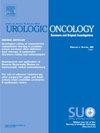IDENTIFICATION OF OVER 40 NOVEL TESTICULAR GERM CELL TUMOR SUSCEPTIBILITY LOCI
IF 2.4
3区 医学
Q3 ONCOLOGY
Urologic Oncology-seminars and Original Investigations
Pub Date : 2025-03-01
DOI:10.1016/j.urolonc.2024.12.087
引用次数: 0
Abstract
Introduction
In the United States, testicular germ cell tumors (TGCT) are the most common cancers in young men with an incidence that has doubled over the past 20 years. TGCT is the most heritable of all cancers. Genome-wide association studies (GWAS) of TGCT led by the Testicular Cancer Consortium (TECAC) have identified variants of moderate effect that explain a large proportion of the high heritability of disease. Identified loci to date implicate genes in pathways associated with male germ cell development, chromosomal segregation, sex determination, and DNA maintenance, together which help to frame the disease biology and epidemiology. The existing polygenic risk scores (PRS) can identify men at 7-fold increased risk of developing TGCT. We present preliminary findings from our current TECAC GWAS meta-analysis.
Methods
Genotype data on 13,667 men with and 220,834 men without TGCT from 11 independent study samples were analyzed. For each study sample, genotypes passing standard SNP- and sample-level quality control were imputed against the Haplotype Reference Consortium r1.1 backbone, and SNP-level quality control was repeated after imputation. Association testing for common variation (MAF ≥ 0.05) was performed using SNPTEST v2.5.6. Meta-analysis with inverse-variance weighting of study-specific summary statistics was performed using METAL r2020.5.5. Genetic markers with significant effect size heterogeneity across studies (p <1×10-05) were removed from further consideration. We are in the process of updating our meta-analysis to include an additional study sample of 3,332 men with and 1,397 men without TGCT for whom low-pass whole genome sequencing (WGS) data was generated by TECAC.
Results
Preliminary results identified 39 novel loci. The most significant locus (rs5987215; p = 1.46 10-15) is intergenic between MECP2 and OPN1LW. Several loci map to genes in known TGCT susceptibility pathways, including male germ cell development and sex differentiation (WT1: rs72908940, p = 2.93 10-8; WNK1: rs2277869, p = 1.05 10-9; GATA4: rs3203358, p = 1.70 10-8; PRC1: rs7167128, p = 9.21 10-11; REXO1: rs28626548, p = 4.05 10-9), chromosomal segregation (MEI1: rs5758426, p = 2.93 10-8; MAPT: rs17662403, p = 3.50 10-13), and RNA transcription (ZNF638: rs6725892, p = 8.26 10-10; TBLP2: rs4901569, p = 2.28 10-8; CNOT2: rs4901569, p = 4.25 10-9; ZNF552: rs140089558, p = 2.74 10-12). Three novel independent markers map to the androgen receptor region (rs4240053, p = 7.75 10-12; rs12390145, p = 6.80 10-14 ; rs17216906, p = 1.96 10-10). Final meta-analysis results on 16,999 men with and 222,231 men without TGCT will be presented at the meeting.
Conclusions
With 39 novel loci identified in our preliminary analysis, we anticipate identifying well over 40 loci in our final analysis, adding substantially to the current number of associated variants. Many loci implicate genes that encode proteins in pathways associated with susceptibility to TGCT, which explain the biological basis of disease development (e.g., chromosomal segregation and whole genome doubling), link to other related conditions (e.g., infertility), and disease epidemiology (e.g., White predominance). Multiple novel markers were identified near the androgen receptor loci, further emphasizing the role of androgen:estrogen balance in TGCT susceptibility. After incorporating our novel findings, we anticipate a significant improvement in PRS leading to improved identification of men at risk of TGCT. Herein, we report the largest GWAS of TGCT to date, which provides multiple novel insights into the disease biology and improved prediction of at-risk individuals.
求助全文
约1分钟内获得全文
求助全文
来源期刊
CiteScore
4.80
自引率
3.70%
发文量
297
审稿时长
7.6 weeks
期刊介绍:
Urologic Oncology: Seminars and Original Investigations is the official journal of the Society of Urologic Oncology. The journal publishes practical, timely, and relevant clinical and basic science research articles which address any aspect of urologic oncology. Each issue comprises original research, news and topics, survey articles providing short commentaries on other important articles in the urologic oncology literature, and reviews including an in-depth Seminar examining a specific clinical dilemma. The journal periodically publishes supplement issues devoted to areas of current interest to the urologic oncology community. Articles published are of interest to researchers and the clinicians involved in the practice of urologic oncology including urologists, oncologists, and radiologists.

 求助内容:
求助内容: 应助结果提醒方式:
应助结果提醒方式:


